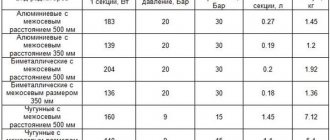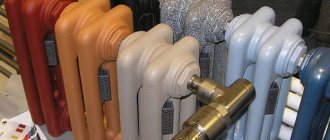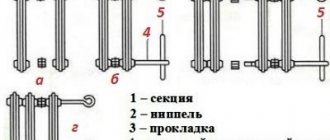Taps on radiators vary in purpose and principle of operation. When choosing suitable shut-off and control valves, knowledge of what types of taps are produced and what design is best to purchase for installation on batteries in a house or apartment will be useful.
Valves
A manual valve or manual shut-off valve for radiators is a device with a double change in the direction of coolant flow inside the structure. The role of the shut-off element in such valves is performed by a rod equipped with an elastic gasket. To change the position of the rod there is a worm mechanism and a handle. Shutting off the coolant supply is achieved by tightly pressing the gasket to the seat. When the handle is rotated smoothly, the passage gradually opens.
The strengths of this device include the ability not only to completely shut off the flow of water, but also to control the intensity of the pressure. On the other hand, the service life of the rubber gasket is limited, which leads to loss of tightness when overlapping. To solve this problem, you have to change the gaskets from time to time (it’s not difficult to do this yourself). The installation of a ceramic crane axle box significantly increases the intervals between scheduled repairs. It works an order of magnitude longer than the idle design with a rod.
All radiator valves are divided into two large groups:
- Straight shut-off valves for radiator. Valves of this type are most often used in lateral connections, where the pipes approach the battery opposite the inlet and outlet.
- Angle radiator shut-off valves. Used for bottom pipe connections.
Balancing valve
The balancing valve of the heating system is intended to regulate the coolant passing through . Liquid consumption depends on pressure. The higher the pressure, the more fluid is consumed. This device is installed on risers. A balanced system ensures continuous operation. The manual valve is used as a diaphragm, and the automatic valve maintains pressure and consumption in the risers. A manual balancing valve can shut off the system. The design is a valve type device. Manual valves can be installed in conjunction with shut-off valves.
Installation of shut-off valves in different sections of the circuit
A variety of heating taps can have different purposes, which is why the installation of devices is carried out in the areas provided for by the project. As a rule, the heating circuit will give clear recommendations as to what type of shut-off valves should complement the various types of radiators connected to the circuit.
Neglecting the recommendations may result in a decrease in the performance of the heating system.
Therefore, it is better for the owner to buy a heating control valve provided for in the project. A valve installed on the radiator to bleed air from the heating system helps prevent air in the radiators and avoid the appearance of cold spots.
Flow regulator
Having installed energy metering devices, the question naturally arises of how you can regulate and control the supply of coolant, limit or add its flow. For this purpose, there are all kinds of automatic regulators, the use of which allows you to save money; they operate from outside air temperature sensors and return pipeline sensors. Another advantage of temperature controllers is that they control the temperature directly at the radiator installation site, unlike other devices. This advantage gives priority in obtaining a uniform temperature background for a comfortable stay in the room. The regulator will prevent overheating of the air in the room, which sensors on centralized automation cannot always track. It is possible to adjust the temperature for each room separately. Sometimes, when solving the adjustment issue, ordinary taps are installed. Of course, this solution reduces financial costs, but deprives a number of useful advantages. The faucet has limited functionality to open and close. There is a danger of stopping or airing the riser. By adjusting the heating using taps it is impossible to achieve the required temperature. Using automatic regulators, you can adjust the system accurately and efficiently.
Source
How to choose taps for different heating systems
In houses with cast iron central heating radiators, only spherical models are installed in case of an accident. Instead of air vents, compact adjustment taps are installed - this is enough for maintenance.
Modern radiators are now installed everywhere in multi-storey buildings, but adjusting the water flow in old heat transfer systems is risky. The radiator elements are installed in series there - therefore, by turning down the heat in your apartment, you can freeze half the house. Only ball fittings are installed in case of leaks and taps to eliminate airiness. In later high-rise buildings with insulated batteries, control devices can also be installed.
In modern houses with autonomous heating there are bimetallic radiators with a complete shut-off and adjustment set:
- Ball shut-off elements - on the inlet and return.
- A control valve or thermostatic valve with a thermal head for correcting the coolant supply.
- Air vent device. This is important because in bimetallic models, air also spoils the metal.
In a private house, any radiators - cast iron, bimetallic, aluminum - do not require thermostatic devices. The boiler copes with this task. It is enough to install shut-off valves to prevent leaks and use air vents.
Modern shut-off and control valves have turned batteries into high-tech devices. Now you can set the desired temperature at home and service radiators without disconnecting the entire heat supply system from the heat supply.
Pressure regulator
The operation of the batteries and the pump is disrupted due to high or low pressure levels. Correct control of the heating system will help to avoid this negative factor. The pressure in the system plays a significant role, it ensures that water gets into the pipes and radiators. Heat loss will be reduced if the pressure is standard and maintained. This is where water pressure regulators come to the rescue. Their mission is primarily to protect the system from too much pressure . The operating principle of this device is based on the fact that the heating system valve located in the regulator works as a force equalizer. Depending on the type of pressure, regulators are classified into: statistical, dynamic. It is necessary to select a pressure regulator based on throughput. This is the ability to pass the required volume of coolant, in the presence of the required constant pressure drop.
Heating Systems Basics
In general, according to the regulations of utility services, it is prohibited to interfere with the operation of the central systems of the house. In exceptional cases, when the battery is leaking or has ruptured, emergency intervention is permitted. But if the heating system in your home is connected to the central system correctly, then you can try turning off the heating yourself. There is nothing particularly difficult about this.
Correct connection means that the heating is connected to the general system using two ball valves (Figure 1) and a jumper called a bypass (Figure 2). This connection is called one-pipe. (Figure 3)
Figure 1 – Two taps
Figure 2 – Bypass jumper
Figure 3 – One-pipe system with a jumper. It can be covered
Important Modern heaters are filled with water, which plays the role of a coolant. In winter, hot water flows through the heating pipes, and cold water in summer. Oddly enough, it is filling with water that saves the insides of the radiator from rusting from the inside. After all, if all the water is drained from the heating system, then its remaining drops will create a microclimate for the formation of corrosion.
Why turn off the battery at the beginning of the heating season?
As soon as they announce that the heating season has begun, it is better to immediately turn off the battery to avoid blockages. The fact is that when hot water starts running, a huge amount of slag will flow through the pipes, which clogs the radiators. Turn on the battery on the second day after the start of the season. This is done simply, open both taps and bleed the air through the Mayevsky tap, which is equipped with most radiators.
Interesting When closing pipes in the summer, you must always remember that the battery must always be filled with water. By closing the valve on the radiator after the end of the heating season, you will leave it filled with water. This will prevent corrosion.
Safety valves
Any boiler equipment is a source of danger. Boilers are considered explosive because they have a water jacket, i.e. pressure vessel. One of the most reliable and widespread safety devices that reduces the danger to a minimum is the safety valve of the heating system. The installation of this device is due to the protection of heating systems from excess pressure . Often this pressure occurs as a result of boiling water in the boiler. The safety valve is installed on the supply pipe, as close to the boiler as possible. The valve has a fairly simple design. The body is made of good quality brass. The main working element of the valve is the spring. The spring, in turn, acts on the membrane, which closes the passage to the outside. The membrane is made of polymer materials, the spring is made of steel. When choosing a safety valve, it should be taken into account that full opening occurs when the pressure in the heating system increases above the value by 10%, and full closure occurs when the pressure drops below the response value by 20%. Due to these characteristics, it is necessary to select a valve with a response pressure higher than 20-30% of the actual one.











